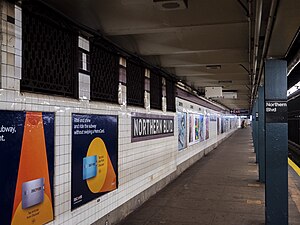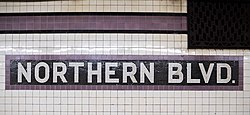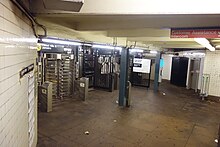Northern Blvd | |||||||||||||||||||||||||||||||||||||||||||||||||||||||||||||||||||||||||||||||||||||||||||
|---|---|---|---|---|---|---|---|---|---|---|---|---|---|---|---|---|---|---|---|---|---|---|---|---|---|---|---|---|---|---|---|---|---|---|---|---|---|---|---|---|---|---|---|---|---|---|---|---|---|---|---|---|---|---|---|---|---|---|---|---|---|---|---|---|---|---|---|---|---|---|---|---|---|---|---|---|---|---|---|---|---|---|---|---|---|---|---|---|---|---|---|
|
| |||||||||||||||||||||||||||||||||||||||||||||||||||||||||||||||||||||||||||||||||||||||||||
 View of northbound platform | |||||||||||||||||||||||||||||||||||||||||||||||||||||||||||||||||||||||||||||||||||||||||||
| Station statistics | |||||||||||||||||||||||||||||||||||||||||||||||||||||||||||||||||||||||||||||||||||||||||||
| Address | Northern Boulevard & Broadway Queens, NY 11377 | ||||||||||||||||||||||||||||||||||||||||||||||||||||||||||||||||||||||||||||||||||||||||||
| Borough | Queens | ||||||||||||||||||||||||||||||||||||||||||||||||||||||||||||||||||||||||||||||||||||||||||
| Locale | Woodside | ||||||||||||||||||||||||||||||||||||||||||||||||||||||||||||||||||||||||||||||||||||||||||
| Coordinates | 40°45′12″N 73°54′25″W / 40.753239°N 73.906918°W | ||||||||||||||||||||||||||||||||||||||||||||||||||||||||||||||||||||||||||||||||||||||||||
| Division | B ( IND) [1] | ||||||||||||||||||||||||||||||||||||||||||||||||||||||||||||||||||||||||||||||||||||||||||
| Line | IND Queens Boulevard Line | ||||||||||||||||||||||||||||||||||||||||||||||||||||||||||||||||||||||||||||||||||||||||||
| Services |
E
F M R | ||||||||||||||||||||||||||||||||||||||||||||||||||||||||||||||||||||||||||||||||||||||||||
| Transit | |||||||||||||||||||||||||||||||||||||||||||||||||||||||||||||||||||||||||||||||||||||||||||
| Structure | Underground | ||||||||||||||||||||||||||||||||||||||||||||||||||||||||||||||||||||||||||||||||||||||||||
| Platforms | 2 side platforms | ||||||||||||||||||||||||||||||||||||||||||||||||||||||||||||||||||||||||||||||||||||||||||
| Tracks | 2 | ||||||||||||||||||||||||||||||||||||||||||||||||||||||||||||||||||||||||||||||||||||||||||
| Other information | |||||||||||||||||||||||||||||||||||||||||||||||||||||||||||||||||||||||||||||||||||||||||||
| Opened | August 19, 1933 | ||||||||||||||||||||||||||||||||||||||||||||||||||||||||||||||||||||||||||||||||||||||||||
| Accessible | not ADA-accessible; accessibility planned | ||||||||||||||||||||||||||||||||||||||||||||||||||||||||||||||||||||||||||||||||||||||||||
| Opposite- direction transfer | No | ||||||||||||||||||||||||||||||||||||||||||||||||||||||||||||||||||||||||||||||||||||||||||
| Traffic | |||||||||||||||||||||||||||||||||||||||||||||||||||||||||||||||||||||||||||||||||||||||||||
| 2023 | 1,400,392
[2] | ||||||||||||||||||||||||||||||||||||||||||||||||||||||||||||||||||||||||||||||||||||||||||
| Rank | 217 out of 423 [2] | ||||||||||||||||||||||||||||||||||||||||||||||||||||||||||||||||||||||||||||||||||||||||||
| |||||||||||||||||||||||||||||||||||||||||||||||||||||||||||||||||||||||||||||||||||||||||||
| |||||||||||||||||||||||||||||||||||||||||||||||||||||||||||||||||||||||||||||||||||||||||||
| |||||||||||||||||||||||||||||||||||||||||||||||||||||||||||||||||||||||||||||||||||||||||||
| |||||||||||||||||||||||||||||||||||||||||||||||||||||||||||||||||||||||||||||||||||||||||||
| |||||||||||||||||||||||||||||||||||||||||||||||||||||||||||||||||||||||||||||||||||||||||||
The Northern Boulevard station is a local station on the IND Queens Boulevard Line of the New York City Subway. Located at the intersection of Northern Boulevard and Broadway, it is served by the M train on weekdays, the R train at all times except nights, and the E and F trains at night.
History

The Queens Boulevard Line was one of the first lines built by the city-owned Independent Subway System (IND), [4] [5] [6] and stretches between the IND Eighth Avenue Line in Manhattan and 179th Street and Hillside Avenue in Jamaica, Queens. [4] [6] [7] The Queens Boulevard Line was in part financed by a Public Works Administration (PWA) loan and grant of $25 million. [8] One of the proposed stations would have been located at Northern Boulevard.
The first section of the line, west from Roosevelt Avenue to 50th Street, opened on August 19, 1933. E trains ran local to Hudson Terminal (today's World Trade Center) in Manhattan, while the GG (predecessor to current G service) ran as a shuttle service between Queens Plaza and Nassau Avenue on the IND Crosstown Line. [9] [10] [11] [12] [13] [14]
Under the 2015–2019 MTA Capital Plan, the station, along with 30 other New York City Subway stations, will undergo a complete overhaul and would be entirely closed for up to 6 months. Updates would include cellular service, Wi-Fi, charging stations, improved signage, and improved station lighting. [15] [16] However, these renovations are being deferred until the 2020–2024 Capital Program due to a lack of funding. [17] In December 2019, the MTA announced that this station would become ADA-accessible as part of the agency's 2020–2024 Capital Program. [18]
In 2019, as part of an initiative to increase the accessibility of the New York City Subway system, the MTA announced that it would install elevators at the Northern Boulevard station as part of the MTA's 2020–2024 Capital Program. [19] In December 2022, the MTA announced that it would award a $146 million contract for the installation of eight elevators across four stations, including Northern Boulevard. [20]
Station layout
| Ground | Street level | Exit/entrance |
| >Platform level | Side platform | |
| Southbound local | ←
← ← | |
| Northbound local |
| |
| Side platform | ||
| B2 Express tracks |
Southbound express | ←
|
| Northbound express |
| |

The station has two tracks and two side platforms. The E and F trains serve the station at night, [21] [22] the M train serves the station on weekdays during the day, [23] and the R train serves the station at all times except late nights. [24] The station is between 46th Street to the west and 65th Street to the east. [25] The express tracks pass underneath the local tracks and not visible from the platforms. West of the station, the express tracks turn south and run along a separate routing under Northern Boulevard.

Both platform walls have a purple tile band with a black border, with a number of replacement tiles in different shades of violet and purple having been placed during repairs. There are also mosaic name tablets reading "NORTHERN BLVD." in white sans-serif lettering on a black background and purple border. Small tile captions reading "N BLVD" in white lettering on black run below the tile band, and directional signs in the same style are present below some of the name tablets.[ citation needed] The tile band was part of a color-coded tile system used throughout the IND. [26] The tile colors were designed to facilitate navigation for travelers going away from Lower Manhattan. As such, the purple tiles used at the Northern Boulevard station were originally also used at Queens Plaza, the next express station to the west, while a different tile color is used at Jackson Heights–Roosevelt Avenue, the next express station to the east. Purple tiles are similarly used at the other local stations between Queens Plaza and Roosevelt Avenue. [27] [28]
Dark teal I-beam columns run along both platforms at regular intervals, alternating ones having the standard black station name plate with white lettering.[ citation needed] The I-beam piers are located every 15 feet (4.6 m) and support girders above the platforms. The roof girders are also connected to columns in the platform walls. [29]: 3 The tunnel is covered by a U-shaped trough that contains utility pipes and wires. The outer walls of this trough are composed of columns, spaced approximately every 5 feet (1.5 m) with concrete infill between them. There is a 1-inch (25 mm) gap between the tunnel wall and the platform wall, which is made of 4-inch (100 mm)-thick brick covered over by a tiled finish. The columns between the tracks are also spaced every 5 feet (1.5 m), with no infill. [29]: 3
There are heavy columns across one part of the station, where the New York Connecting Railroad to the Hell Gate Bridge crosses over. There is an older style wooden token booth in the mezzanine of the uptown entrance.
In the western half of this station, the express tracks go underneath the local tracks to run along Northern Boulevard. A short distance east of here, the express tracks rise to the same level as the local tracks. To the south (geographical west) of this station, there was a single crossover connecting the two tracks. In May 2019, this crossover was removed as part of the communications-based train control installation on the IND Queens Boulevard Line, which entailed the removal of under-used interlocking towers such as the Northern Boulevard crossover. [30] [31]
There is an emergency exit at the western end of the northbound platform at this station, which leads to the D3 and D4 express tracks below.
Exits
The station's exits are at the western end at Northern Boulevard and Broadway. Fare controls are at platform level and there are no crossovers or crossunders. The booth on the southbound side is full-time. Each fare control area has one street stair to the intersection of Broadway, 54th Street, and Northern Boulevard.
There are closed exits at the eastern end on both sides. [32] IND "56th Street" direction tiles and arrows suggest that the exits lead to the intersection of 56th Street and Broadway; they have been left intact on both platforms under some of the "Northern Blvd" station tablets. The exit from the Manhattan-bound platform will be reopened as a part of the ADA accessibility improvements; it will receive an elevator. [33]
References
- ^ "Glossary". Second Avenue Subway Supplemental Draft Environmental Impact Statement (SDEIS) (PDF). Vol. 1. Metropolitan Transportation Authority. March 4, 2003. pp. 1–2. Archived from the original (PDF) on February 26, 2021. Retrieved January 1, 2021.
- ^ a b "Annual Subway Ridership (2018–2023)". Metropolitan Transportation Authority. 2023. Retrieved April 20, 2024.
- ^ "Annual Subway Ridership (2018–2023)". Metropolitan Transportation Authority. 2023. Retrieved April 20, 2024.
- ^ a b Duffus, R.L. (September 22, 1929). "OUR GREAT SUBWAY NETWORK SPREADS WIDER; New Plans of Board of Transportation Involve the Building of More Than One Hundred Miles of Additional Rapid Transit Routes for New York". The New York Times. Retrieved August 19, 2015.
- ^ "QUEENS SUBWAY WORK AHEAD OF SCHEDULE: Completion Will Lead to Big Apartrnent Building, Says William C. Speers". The New York Times. April 7, 1929. Retrieved September 1, 2015.
- ^ a b "Queens Lauded as Best Boro By Chamber Chief". Brooklyn Daily Eagle. September 23, 1929. p. 40. Retrieved October 4, 2015 – via Newspapers.com.
- ^ New York Times, New Subway Routes in Hylan Program to Cost $186,046,000, March 21, 1925, page 1
- ^ "TEST TRAINS RUNNING IN QUEENS SUBWAY; Switch and Signal Equipment of New Independent Line Is Being Checked". The New York Times. December 20, 1936. ISSN 0362-4331. Retrieved April 26, 2016.
- ^ Kramer, Frederick A. (1990). Building the Independent Subway. Quadrant Press. ISBN 978-0-915276-50-9.
- ^ Raskin, Joseph B. (2013). The Routes Not Taken: A Trip Through New York City's Unbuilt Subway System. New York, New York: Fordham University Press. doi: 10.5422/fordham/9780823253692.001.0001. ISBN 978-0-82325-369-2.
- ^ "Independent Subway Services Beginning in 1932". thejoekorner.com. August 21, 2013. Retrieved August 2, 2015.
- ^ "TWO SUBWAY UNITS OPEN AT MIDNIGHT; Links in City-Owned System in Queens and Brooklyn to Have 15 Stations" (PDF). The New York Times. August 18, 1933. Retrieved November 7, 2015.
- ^ "New Queens Subway Service Will Be Launched Tonight; Tunnel From Manhattan Open to Jackson Heights; Service Will Eventually Be Extended Through To Jamaica". Long Island Daily Press. Fultonhistory.com. August 18, 1933. p. 20. Retrieved July 27, 2016.
- ^ "New Queens Tube To Open Saturday: Brooklyn-Long Island City Link of City Line Also to Be Put in Operation". New York Evening Post. Fultonhistory.com. August 17, 1933. p. 18. Retrieved July 27, 2016.
- ^ Whitford, Emma (January 8, 2016). "MTA Will Completely Close 30 Subway Stations For Months-Long "Revamp"". Gothamist. Archived from the original on August 1, 2016. Retrieved July 18, 2016.
- ^ "MTAStations" (PDF). governor.ny.gov. Government of the State of New York. Retrieved July 18, 2016.
- ^ Berger, Paul (April 3, 2018). "New York Subway Cuts Back Plans to Renovate Stations". Wall Street Journal. ISSN 0099-9660. Retrieved April 3, 2018.
- ^ "Press Release - MTA Headquarters - MTA Announces 20 Additional Subway Stations to Receive Accessibility Improvements Under Proposed 2020-2024 Capital Plan". MTA. December 19, 2019. Archived from the original on April 21, 2020. Retrieved December 20, 2019.
- ^ "Press Release - MTA Headquarters - MTA Announces 20 Additional Subway Stations to Receive Accessibility Improvements Under Proposed 2020-2024 Capital Plan". mta.info. Metropolitan Transportation Authority. December 19, 2019. Archived from the original on April 21, 2020. Retrieved December 20, 2019.
- ^ "Capital Program Oversight Committee Meeting December 2022". mta.info. Metropolitan Transportation Authority. December 19, 2022. pp. 107–109. Retrieved July 14, 2022.
- ^ "E Subway Timetable, Effective December 4, 2022". Metropolitan Transportation Authority. Retrieved August 26, 2023.
- ^ "F Subway Timetable, Effective August 28, 2023". Metropolitan Transportation Authority. Retrieved August 26, 2023.
- ^ "M Subway Timetable, Effective August 28, 2023". Metropolitan Transportation Authority. Retrieved August 26, 2023.
- ^ "R Subway Timetable, Effective August 28, 2023". Metropolitan Transportation Authority. Retrieved August 26, 2023.
- ^ "Subway Map" ( PDF). Metropolitan Transportation Authority. September 2021. Retrieved September 17, 2021.
- ^ "Tile Colors a Guide in the New Subway; Decoration Scheme Changes at Each Express Stop to Tell Riders Where They Are". The New York Times. August 22, 1932. ISSN 0362-4331. Archived from the original on July 1, 2022. Retrieved July 1, 2022.
- ^ Carlson, Jen (February 18, 2016). "Map: These Color Tiles In The Subway System Used To Mean Something". Gothamist. Retrieved May 10, 2023.
- ^ Gleason, Will (February 18, 2016). "The hidden meaning behind the New York subway's colored tiles". Time Out New York. Retrieved May 10, 2023.
- ^ a b " New York MPS Elmhurst Avenue Subway Station (IND)". Records of the National Park Service, 1785 - 2006, Series: National Register of Historic Places and National Historic Landmarks Program Records, 2013 - 2017, Box: National Register of Historic Places and National Historic Landmarks Program Records: New York, ID: 05000672. National Archives.
- ^ "MTA awards L.K. Comstock Queens Boulevard Line signaling contract". Railway Track and Structures. January 5, 2017. Retrieved June 6, 2019.
- ^ Dj Hammers (May 31, 2019), The Removal of Northern Boulevard Interlocking, archived from the original on December 21, 2021, retrieved June 6, 2019
- ^ "MTA Neighborhood Maps: Astoria" (PDF). Metropolitan Transportation Authority. 2015. Retrieved September 27, 2015.
- ^ "Community Board 1 Queens Transportation Committee". YouTube. June 1, 2023. Retrieved June 1, 2023.
External links
- nycsubway.org – IND Queens Boulevard Line: Northern Boulevard
- Station Reporter — R Train
- Station Reporter — M Train
- The Subway Nut — Northern Boulevard Pictures
- Northern Boulevard entrance from Google Maps Street View
- Platforms from Google Maps Street View


